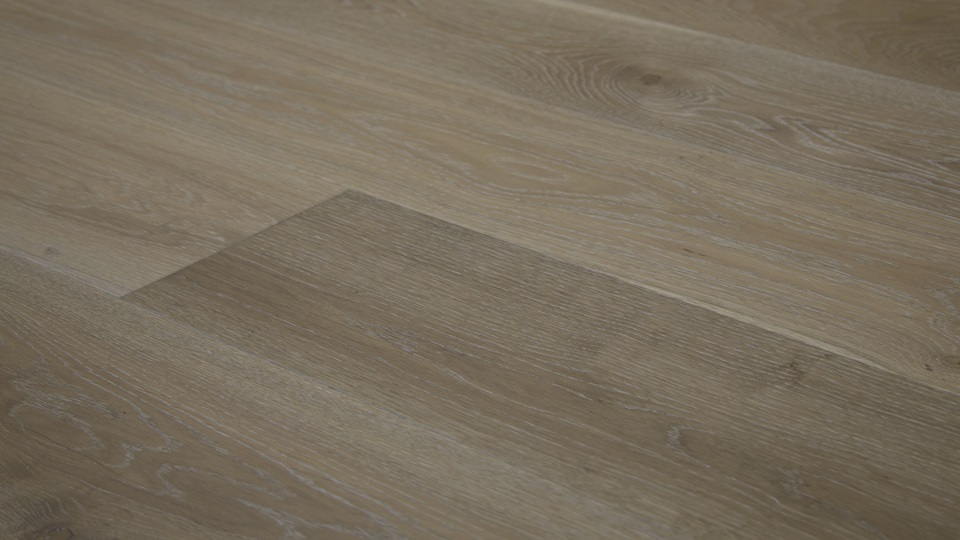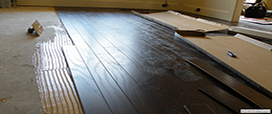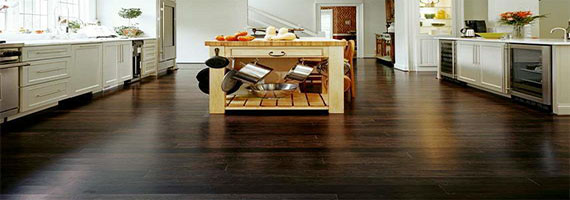
See all the flooring products at Ferma Flooring Learn more
Installation – Vinyl Plank
FERMA Luxury Vinyl flooring replicates the look of a natural product which has natural variations in color and texture. For best visual effect, shuffle planks from several cartons and do not install similar boards next to one another.
- Installation – Luxury Vinyl Download
-
Pre-Installation Subfloor Requirement
- All subfloors must be: dry, structurally sound, clean (thoroughly swept and free of all debris), Level (flat to 3/16″ per 10-foot radius)
- Wood subfloors must be dry and well secured. Nail or screw every 6″ along joists to avoid squeaking. If not level, sand down high spots and fill low spots with a Portland Based leveling patch.
- Concrete subfloors must be fully cured and should have appropriate moisture barrier film between concrete and ground. The subfloor should be flat and level within 3/16″ per 10 radii. If necessary, grind high spots down and level low spots with a Portland leveling compound.
- Ceramic Tile, resilient tile and sheet vinyl must be well-bounded to subfloor, in good condition, clean and level. Do not sand existing vinyl floors, as they may contain asbestos.
-
Pre-Installation Jobsite Requirements
- Carefully examine the flooring prior to installation for color, finish, and quality. Ensure adequate lighting for proper inspection. If flooring is not acceptable, contact your supplier immediately and arrange for a replacement. FERMA cannot accept responsibility for flooring installed with visible defects. Prior to installation of any flooring, the installer must ensure that the job site and subfloor meet the requirements of these instructions. FERMA FLOORING is not responsible for flooring failure resulting from an unsatisfactory job site and/or subfloor conditions.
- Flooring should be one of the last items installed in any new construction or remodel project.
- Although this flooring is waterproof it is not a moisture barrier.
- Crawl spaces must be a minimum of 18″ from the ground to the underside of the joists. A ground cover of minimum 6mil black polyethylene film is essential as a vapor barrier with joints lapped 6″ and sealed with moisture resistant tape. The crawl space should have perimeter venting equal to a minimum of 1.5% of the crawl space square footage. These vents should be properly located to foster cross ventilation. Where necessary, local regulations prevail.
- Room temperature and humidity of installation area should be consistent with normal, year-round living conditions for at least one week before installation of flooring. Maintaining an optimum room temperature of 70 F and a humidity range of 30-50% is recommended. Acclimate flooring by storing the packages in the room or rooms to be covered for at least 24 to 48 hours at normal temperature before installation.
-
Installation Tools
For all installation methods:
- Tape measure
- Tapping block (trimmed pieces of flooring)
- Pencil
- Pry bar or pull bar
- Chalk line
- Crosscut power saw
- 3M scotch-Blue 2080 Tape or Equivalent Tape
- Rubber mallet
-
Acceptable Subfloor Types
- CDX Underlayment Grade Plywood (at least 1/2″ thick)
- Underlayment grade particleboard
- OSB (at least 3/4″ thick)
- Concrete Slab
- Existing wood floor
- Ceramic tile
- Resilient tile & sheet vinyl
-
Starting your installation
- Work from several open boxes of flooring and “dry lay” the floor before permanently laying the floor. This will allow you to select the varying grains & colors and to arrange them in a harmonious pattern. Remember, it is the installers’ responsibility to determine the expectations of what the finished floor will look like with the end user first and then to cull out pieces that do not meet those expectations.
- Begin installation next to an outside wall. This is usually the straightest and best reference for establishing a straight working line. Establish this line by measuring an equal distance from the wall at both ends and snapping a chalk line. The distance you measure from the wall should be the width of a plank. You may need to scribe cut the first row of planks to match the wall in order to make a straight working line if the wall is out of straight.
- You may want to position a few rows before starting installation to confirm your layout decision and working line. When laying flooring, stagger and joints from row to row by at least 8″. When cutting the last plank in a row to fit, you can use the cut-off end to begin the next row. If cut-off end is 8″ in length or less, discard it and instead cut a new plank at a random length and use it to start the next row. Always begin each row from the same side of the room. When near a wall, you can use a pry to pry close the side and end joints.
-
Installation Instructions
Inspection: prior to installation, inspect planks in daylight for visible faults/damage. Check if subfloor/site conditions comply with the specifications described in these instructions. If you are not satisfied do not install, and contact your supplier.
- Before Laying: Measure the room at right angle to the direction of the planks. For best visual effect, planks in the final row should be at least 2 inches wide (half width of plank minimum). For this purpose, planks in the first row can be cut to smaller size. Shuffle planks in order to obtain a pleasant blend of shades. Lay planks preferably following the direction of the main source of light. We recommend laying on wooden floors crossways to the existing floorboard. Planks must not be nailed or screwed to the subfloor. Base boards and molding must not be fixed in away which restricts the movement of the floor.
-
Installing the First Row
- Adjust row so end cut is not less than 8″
- Use spacers to allow 1/4″ expansion gap between the planks and the walls, or stationary interior room objects, so there is room for normal expansion and movement.
- Starting from the LEFT with the tongue facing the wall, carefully place the first board in place. FIGURE 1.
- Engage the end joint of the second plank into the end joint of the first plank at a 45-degree angle. The board must be flat to engage completely. Tap lightly into place by using a rubber mallet and tapping block made from a trimmed piece of flooring to firmly lock short end. Continue in this manner until reaching the final plank in the first row.
- Cut the final board piece to length.
- Begin the second row with the cut piece from the first row. If the cut piece is shorter than 8″, do not use it. Instead, begin with a new board that is at least 8” in length and allow 8″ between the end joints on the adjacent planks. FIGURE 2.
- Position the first board of the second row in place by angling it up slightly, pushing forward and interlocking the long side of the tongue. Slide the board to the left as necessary to align the edges of the end joint of the first row. Carefully push the board down until the tongue and groove lock together on the long side and ends. Gently tap to help engage long ends.
- Install second board of the second row (same as step 7 above). Slide second board close to ending joint of the first board without touching it. Ensure board lays flat. Figure 3.
- Tap firmly but gently on end joint with a rubber mallet and tapping block to fully engage short end. Figure 7.
- Before moving on to the next board, ensure the end and long joints are flush and tight.
- Install the remaining boards and rows in the same manner. Figure 4 & 5.
- Cut the last board to size. If necessary, complete the tight fit by tapping the board into place with a pull bar.
- Whenever practical, use cut pieces from the previous row as the starter board to reduce waste. Pieces must be a minimum of 8″.
- Maintain 8″ spacing between end joints after the first four rows for best appearance.
-
Expansion gaps & Transition Requirements
- Maintain 1/4″ expansion gap around roo perimeter.
- Square/rectangle areas over 26″ long or 36″ wide need transition pieces.
- No-square rooms must have expansion or transition gaps separating them.
- Transitions at doorways are required.
-
Installation Final Row
- The last row may need to be cut lengthwise (ripped)
- Place the last row of planks to be fit on top of the last row of installed planks. Use a piece of the plank as a scribe to trace the contour of the wall.
- Mark where the board will be cut. If the fit of the wall is simple and straight, simply measure for the correct fit and cut.
- After then boards are cut, position planks and tighten the fit using the pull bar.







-
Installing Under a Door Jamb
- Installation under moldings (such as door jambs) may require that the top lip of the groove on the end be reduced in size.
- Using a small plane or knife plane, carefully shave off the ledge of the groove. Figure 6.
- After the groove ledge has been trimmed, place the board in place and tighten with a pull bar to test for fit. The installer must be sure that the required expansion gap has been maintained and the flooring is not pinched.
- If fit is not correct, re-trim as necessary.
- Place a bead of wood glue on the bottom lip of the groove.
- Insert the tongue into the groove and tighten the fit with a pull bar. Hold the board in place with painters tape (3M scotch-Blue 2080 Tape or equivalent) until the glue is dry. Do not use masking tape or duct tape as they may damage the floors finish.
-
After Installation
- Flooring should be one of the last items installed in a project. In order to protect the floors while other trades are finishing their work prior to final cleanup and turnover to the owner, use rosin paper and only use 3M Scotch-Blue 2080 Tape (or equivalent) to hold the rosin paper to the floor. Clean the floor thoroughly before laying the rosin paper to ensure that no debris is trapped underneath.
- DO NOT USE plastic film or other non-breathing coverings as this can cause the floor to become damaged from humidity buildups.
- Dust mop or vacuum your floor to remove any dirt or debris.
- It is suggested that you buff the floor with lamb’s wool pads in order to remove any loose splinters, residues, foot prints, etc.
- Install any transition pieces that may be needed (reducers, T-moldings, nosing, etc.).
-
Further Information
FERMA FLOORING is a member of National Wood Flooring Association (NWFA). FERMA recommends installation by experienced professionals who subscribe to installation standards as set forth by NOFMA, NWFA. For further information about the installation of solid wood flooring, please refer to related instruction by NWFA as follows:
Downloads
- Solid Strip and Plank Installation NWFA Installation Guide
For more technical information about the installation, please also refer to other associated instructions by NWFA as follow:





